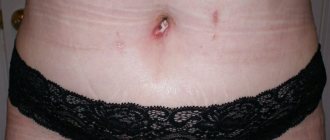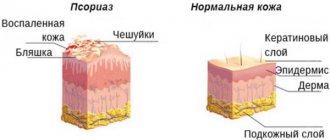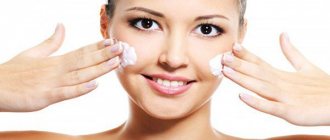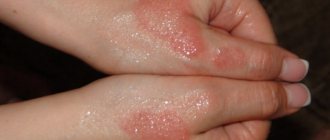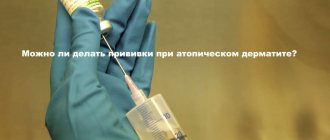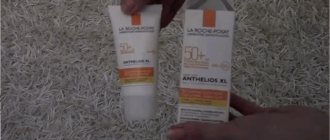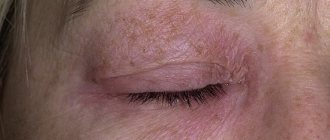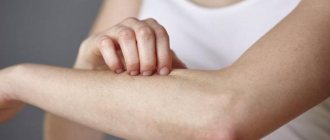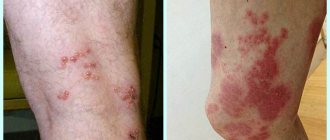Urticaria pigmentosa (mastocytosis) is a rare disease accompanied by specific itchy rashes, reminiscent of ordinary urticaria, after which brown or brownish pigmented spots remain. Caused by active division and accumulation of mast cells (heparinocytes, mast cells). Urticaria pigmentosa is most often diagnosed in infants and resolves on its own by adolescence. Less commonly, mastocytosis is diagnosed after 14 years of age and lasts with relapses throughout life; it can also acquire the character of a systemic pathology. In severe cases, it turns into a malignant form - mast cell leukemia, which can be fatal.
Mechanism of development and causes of mastocytosis
Urticaria pigmentosa, or mastocytosis, can be a consequence of both autoimmune reactions and processes not related to immunity. It is provoked by the excessive release of mast cells and heparinocytes in various tissues, including the epidermal layer. With the breakdown of specific mast cells, which can be provoked by various unfavorable factors (external or internal), histamine, heparin and other mediator substances (provocateurs) of the inflammatory process enter the skin and subcutaneous tissue. They provoke swelling of the epithelium and increase the permeability of blood vessels and capillaries. As a result, visible skin defects are formed, which are accompanied by:
- pressure instability;
- high temperature;
- activation of gastric juice production;
- unbearable itching.
Excessive synthesis of histamine and other bioactive components (inflammatory mediators) causes an acute allergic reaction. Causes of an acute allergic reaction:
- temperature influence;
- rubbing;
- injury;
- squeezing;
- direct rays of the sun;
- climate change;
- stress;
- intoxication (poisoning);
- medicines;
- food (citrus fruits, bright vegetables, seafood).
The skin with mastocytosis acquires a dark color from brown to brown at the site of the rash.
The reason is the accumulation of melanocytes and excessive deposition of melanin - a natural coloring pigment on which the color of hair, skin, and eyes depends. Hives can be inherited from parents to children.
Diet
The main rule in curing urticaria is following a diet. The menu should not include fatty, salty foods and spicy seasonings. Also, when creating a hypoallergenic diet, you need to exclude alcoholic beverages.
People who are faced with this disease need to minimize saturated fats. At the same time, Omega fatty acids must be included in the diet. They are found in avocados, vegetable oils and nuts.
A prerequisite is the daily consumption of water in a volume of 1.5 liters. There should be fruits and vegetables on the table. Eating foods rich in fiber is considered important. It is included in cereals and whole grain bread.
Food should contain natural oils such as olive or coconut. At the same time, you need to minimize salt and sugar.
This diet should be followed by expectant mothers. A properly formulated diet will help prevent the appearance of urticaria pigmentosa. In this regard, you need to completely avoid foods that cause allergic reactions.
These products include sweet carbonated drinks, chocolate and bakery products. You should avoid eating smoked meats and sausages.
You need to include sour cream and cottage cheese in your diet. Particular attention should be paid to greenery. You can eat boiled beef and turkey. It is better to drink still mineral water and rosehip decoction. You can also use unsweetened compotes.
Symptoms in adults and children
Mastocytosis in adults and adolescent children is manifested by oval and round papules with a diameter of up to one centimeter. They can be numerous or single, have clearly visible outlines and a glossy surface without peeling. Their color varies from light gray to brown and even brown. Gradually, the rash spreads to other parts of the body, including the face. The skin is itchy and inflamed, symptoms may subside temporarily and then return to severity again.
Mastocytosis in childhood has similar symptoms and usually appears at 1-2 years of age. The child's skin begins to itch very much, then characteristic rashes form on it. The contents of the rash are cloudy or transparent, sticky, mixed with blood. With any, even minor, damage and thermal influences, the rash undergoes Darier-Una syndrome (“inflammation”) - it enlarges, becomes very red and itches unbearably. After the mastocytosis rash disappears, dark spots remain on the body.
A common location for mastocytosis rashes is the torso. Less commonly, rash and pigmentation due to mastocytosis spread to the limbs and face.
With urticaria, the integument of a child’s body gradually becomes coarser, becomes horny, turns yellow, and deepens in folds. With large accumulations of rash in the groin, the symptoms of the disease are supplemented by burning and pain during body movements.
Classification by skin lesions
Doctors distinguish several types of urticaria pigmentosa:
- Maculopapular urticaria or mastocytosis are large spots with distinct edges on all surfaces of the skin. Similar urticaria pigmentosa is observed in adults and infants with the same frequency.
- Nodular urticaria is small nodules with a glossy surface, the color of which varies from yellow to brown. They can appear in islands, are solitary, and sometimes merge into huge plaques. This form of the disease is observed mainly in infants.
- Erythrodermic mastocytosis - patchy roughening of the skin, yellowing, severe itching, cracks and ulcerations. At a young age, this form of urticaria is not accompanied by a blistering rash, unlike in adults.
- Bullous urticaria is a patchy papular rash with multiple small blisters on the surface that merge into plaques. More often it affects infants and children of kindergarten age.
- Telangiectatic mastocytosis is a patchy rash similar to telangiectasias (spider veins), resembling freckles. They cover the face and chest, but can also be found on other parts of the body. This form is typical for adult women.
- Diffuse mastocytosis is thickening and yellowing of the skin in infants in the genital area and armpits. Rough skin is easily damaged, causing painful wounds to constantly form on it.
Bottom line
Few people have heard about mastocytosis, which is not strange, because the disease is quite rare.
Most often it is diagnosed in children, and it mainly affects young children under two years of age, which significantly aggravates the situation.
At the moment, it is still unknown why the pigmentary type of urticaria occurs, but there are several assumptions.
If you have symptoms, it is important to contact a dermatologist as soon as possible, undergo all the necessary examinations and begin treatment to help reduce your baby’s symptoms.
Possible complications and consequences
When urticaria moves into the systemic stage, when the entire body suffers, various internal organs begin to be actively affected by disintegrating mast cells. The functions and condition of these organs are disrupted, which causes pain in the bones, hardening of the liver (the tissue of internal organs is modified), diarrhea, ulcerative painful processes in the gastrointestinal tract, hardening of the spleen.
Left untreated, urticaria can develop into systemic mastocytosis with extensive damage to vital organs. This form of the disease often ends in death.
Sometimes cutaneous mastocytosis becomes malignant and causes leukemia, which is manifested by enlarged lymph nodes and damage to the nervous system. This complication is difficult to treat and often ends in death.
Forms of the disease
Due to the fact that the disease is associated with the proliferation of mast cells, another name can be found in the medical literature - mast cell leukemia. People may hear the name “urticaria pigmentosa.”
The disease is not a life-threatening pathology, but it can bring considerable discomfort to the patient. More than 70% of cases are mastocytosis in children. The first symptoms usually begin to appear in children under two years of age, and by puberty the disease may go away on its own.
There are two large groups of the disease. These are cutaneous and systemic mastocytosis. The first form is more typical for childhood. Infantile mastocytosis can develop from the first days of a baby's life. A characteristic sign of the disease is damage to only the superficial layers of the skin. The organs are not harmed. As we age, mast cells may appear on the heart, kidneys, lungs, and other internal organs.
Severe skin itching is one of the signs of the disease
Systemic mastocytosis is more common in the adult population. The disease is most often indolent. There are practically no changes on the skin. At the same time, the number of mast cells on the walls of internal organs gradually increases. An aggressive course of the disease is less commonly diagnosed, when the number of pathological cells rapidly increases. Malignant degeneration of mast cells cannot be excluded. In this case, therapy should be prescribed by an oncologist.
There are four degrees of severity of the disease:
- First degree. Light flow. There are practically no complications.
- Second degree. Moderate current. Lack of timely prevention can lead to the development of complications.
- Third degree. Heavy current. Complications appear quite often.
- Fourth degree. The most complex course requiring treatment in a hospital setting.
How is it diagnosed?
If acute allergic urticaria occurs in adults, adolescents and infants, you should contact a therapist, pediatrician, hematologist, allergist, or dermatologist. Cutaneous mastocytosis is diagnosed using:
- standard blood tests (general analysis, biochemistry);
- skin biopsies to detect cells in the affected tissues that, when destroyed, provoke inflammation;
- biopsies of affected organs;
- chromosome research;
- X-ray examination;
- MRI, ultrasound, CT.
During diagnosis, mastocytosis must be distinguished from nevi, reticulosis, dermatofibroma, pemphigus (in newborns), lymphogranulomatosis, hemangioma, xanthoma, and drug rash. Without the listed tests, it is impossible to make an accurate diagnosis.
Diagnostics
The diagnosis of urticaria pigmentosa is made based on a visual examination of the patient.
An allergist (or dermatologist) can test an area of skin for the presence of mast cells by rubbing it . If dark red or brown rashes appear at the site of friction, this indicates the presence of urticaria pigmentosa.
Tests such as:
- skin biopsy to determine the total mast cell count;
- analysis for histamine in urine;
- a complete blood test to determine tryptase levels (tryptase is an enzyme found in mast cells);
- bone marrow biopsy;
- A skeletal bone scan (x-ray) may show areas of bone thinning.
Systemic mastocytosis is also diagnosed by bone marrow and skin biopsy.
Most often, skin lesions resulting from urticaria pigmentosa look the same (in color and shape). Lesions that are different from others may be a sign of cancer.
Possible types of cancer:
- melanoma;
- basal cell carcinoma;
- actinic keratosis (seborrheic).
Seeing a doctor if you suspect urticaria pigmentosa is inevitable .
Ambulance may be needed if:
- The patient has difficulty breathing and wheezing is heard.
- Swelling of the throat or tongue has appeared.
- The patient notes a constant feeling of weakness, there are symptoms such as high fever or chills.
- There is a persistent feeling of nausea, vomiting or diarrhea.
Treatment options
Mastocytosis is treated only in adults and adolescent children; in newborns, it often goes away quickly on its own (if there are no complications). There is no special targeted therapy, so symptomatic treatment is used, as for allergies. Urticaria pigmentosa can be cured with medications, physiotherapy and folk remedies. In the future, it is necessary to observe prophylaxis to prevent relapses.
Pharmacy drugs
Therapy for urticaria pigmentosa is selected individually, taking into account the form, symptoms and extent of the lesion.
The body can be treated with antiseptic solutions, antibacterial ointments (in case of suppuration) and local corticosteroids - Sinaflan, Akriderm, Triderm, Belosalik to relieve itching and reduce inflammation.
Effectively used in the treatment of mastocytosis:
- antiallergic medications - Cetirizine, Tavegil or Suprastin;
- systemic steroids – Kenalog, Prednisolone, Cortineff;
- antiserotonin medications, for example, Periactin;
- medications containing cromoglyceric acid - Nalkrom;
- cytostatics;
- Histaglobulin (for severe forms of urticaria).
Physiotherapy
PUVA physiotherapy is used to treat urticaria. The procedure involves alternately exposing skin rashes to photoactive medications and long-wavelength UV rays.
Other measures
With mastocytosis, you definitely need a diet from which all potentially allergenic foods are excluded: citrus fruits, eggplants, smoked meats, seafood, and some products with extractive substances in their composition. It is strictly forbidden to consume alcoholic beverages; it is also better to give up other bad habits.
Among the folk remedies for the treatment of urticaria, you can use nettle decoctions for oral administration, celery juice, lotions and compresses from chamomile, string, dill, medicinal baths with soda, oak bark, compresses from raw potatoes.
Therapeutic measures
The treatment course is quite individual, even if it is necessary to use standard medications. It all depends on the form of the disease, the symptoms, and the age of the patient.
In young children who, apart from the rash, do not have any other serious changes in the skin or organs, therapy is not prescribed, since everything goes away on its own.
Various products that prevent skin softness (baby powder, creams, etc.) may also be recommended.
In severe forms of the disease, treatment consists of taking special medications that are aimed at eliminating the symptoms, since the disease itself is almost impossible to cure. These include:
- antiserotonin (Periatin, etc.);
- antihistamines (Cetirizine, etc.);
- anti-bradykinin (Prodectin, etc.);
- cytostatics;
- products containing cromoglyceric acid (Intal, etc.);
- corticosteroids.
If instead of blisters, mastocytosis manifests itself in the baby as small nodules, then he may be prescribed the use of Histaglobulin. In addition to drug therapy, the disease can be eliminated externally.
PUVA therapy, which consists of a combined effect on the skin using medicinal photoactive substances, as well as long-wave UV rays, can help treat urticaria pigmentosa. It is extremely rare that surgical removal of pigmented lesions may be necessary.
How effective is treatment and how to prevent relapse
The effectiveness of treatment for mastocytosis depends on many factors, especially the age of the patient. In infancy, urticaria disappears on its own before puberty in 75% of cases. In adolescents, successful recovery from urticaria is observed in 50% of cases. In adults, the prognosis is unfavorable - mastocytosis quickly becomes systemic and can lead to death.
To prevent relapse of mastocytosis after successful treatment of urticaria pigmentosa, it is recommended to avoid factors that provoke an increase in the number of mast cells in the body. These factors for mastocytosis include:
- stress;
- colds;
- prolonged exposure to the sun;
- injuries;
- intoxication;
- food and other allergic reactions.
Only in this case will it be possible to avoid subsequent relapses of urticaria and prevent complications.
The danger of urticaria pigmentosa
The main danger of the disease is its systemic form, which may not manifest itself at first. Most often it affects the bones, gastrointestinal tract and liver. Sometimes it can affect the lungs. Usually this is all accompanied by weakness, headache, and fever. However, there are no visible manifestations of the disease, and the person can begin treatment for a completely different diagnosis.
You can learn about the contagiousness of the disease from our material.
